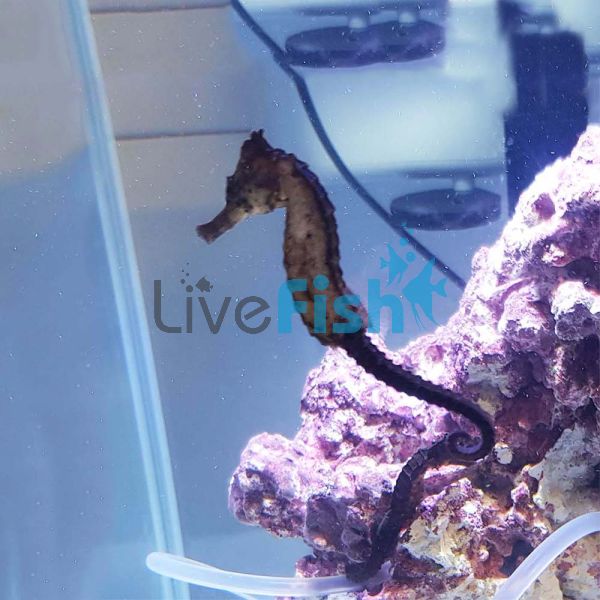Kuda Seahorse 5cm
- Buy 2 for $82.10 each and save 10%
- Buy 4 for $72.98 each and save 20%
Kuda Seahorse
The Kuda Seahorse has a variety of colouration. It can be pale yellow or black and covered with dark circles, spots, or bands. It is also able to shift colour to match its’ surroundings. Using its camouflage to hide from predators.
Kuda Seahorses can grow up to 28 centimeters (11 in).
It is difficult to distinguish males and females during the first 6 months. Differences are more clear during mating. It should be possible to see the male's brooding pouch, and its’ anal fin is smaller than the females.
Kuda Seahorses stay with the same partner, only seeking a new mate if their partner dies. Mating starts with the male performing a courtship ritual. This ritual involves changing its’ colouration and dancing around the female. The mating pair will entwine their tails and move over the seabed until they are facing each other. The female uses her ovipositor to deposit her eggs in the males brooding pouch. This repeats every morning, even after the male is pregnant.
Kuda Seahorses are best suited to the same species only aquarium, either as a pair or in small groups. It is not advised to house them with territorial, aggressive, or fast-moving fish.
Small crustaceans are at risk if housed in the same tank as the seahorses may eat them. Seahorses will often attach themselves to stationary objects in an aquarium. They will not venture too far from their chosen holdfast. Only choosing somewhere new if the habitat gets destroyed or their partner dies.
Breeding is not easy, and if there is a success, the babies are difficult to feed.
The average lifespan for these Seahorses is 2-5 years.
Tank Recommendations for the Kuda Seahorse
Caring for Seahorses isn't as hard as people think. They do not have many natural defenses and have a delicate immune system. A tank needs to have completed the aquarium nitrogen cycle before housing them.
A single pair of Seahorses can live in a 50-gallon (189 liter) tank. Add 10 gallons for each extra pair. Avoid housing with small crustaceans as they may eat them.
Natural habitats include coastal areas, mangroves, estuaries, harbors, and pelagic open water environments.
Kudo Seahorses are reef safe. It is preferable to keep them in a tank with a weak current on account of their poor swimming ability.
Seahorses need objects in the tank that they can hold on to. They will use their prehensile tails for this. Objects like artificial plants, smooth rocks, artificial branches, or corals are ideal. Trying to avoid Sharp rocks and corals to make sure they don't hurt themselves.
Seahorses are very sensitive to rapid changes in salinity. It is important to check the specific gravity of the tank and transport water. Then to acclimatize them slowly if the salinities are very different.
Suitable Tank Buddies
Kuda Seahorses are peaceful and best housed with their own species or with small, shy, non-aggressive fish.
There are few animals that are suitable to co-habit with seahorses. Many are detrimental to the seahorse's quality of life and they may eat small crustaceans.
Usually Compatible
It is preferable to house Kudo Seahorse’ with their own species, but Dragonets may be suitable tank buddies. Other safe options include Gorgonians, Feather Dusters, small Hermit Crabs, Snails, and Peppermint Shrimp.
Sometime Compatible
Be careful if keeping with Dartfish, Gobies, and Jawfish.
Rarely Compatible
Small Invertebrates are often eaten. Don't keep them with aggressive, territorial, or fast-moving fish competing for food. Avoid Angels, Anthias, Blennies, Chromis Damsels, Puffers, Filefish, and Wrasse as these compete for food. Whilst Groupers, Lions/Scorpions, Sharks/Rays, Tangs, Triggers may all eat them.
Feeding Your Kuda Seahorse
Kudo Seahorses are carnivorous. In the wild, they survive on a diet of live-moving food, such as small shrimp and crustaceans.
These Kuda Seahorses have are captivity bred and are eating frozen Mysis Shrimp.
They also eat small crustaceans such as amphipods and organisms attached to live rock. Consuming food is a slow process, so give them at least 2 small servings per day.
| Scientific Name | Hippocampus kuda |
|---|---|
| Care Level | Hard |
| Common Names | Common Seahorse, Estuary Seahorse, Spotted Seahorse or Yellow Seahorse |
| Diet | Carnivore |
| Fish Family | Syngnathidae |
| Lifespan (years) | 4 |
| Max. Length (cm) | 28 |
| Min. Tank Volume (l) | 50 Liters |
| Origin | Indo-Pacific |
| Reef Safe | Yes |
| Sociability | Peaceful |
| Water Conditions | 22 - 26 C, dKH 8-12, pH 8.1-8.4, sg 1.020-1.025 |



